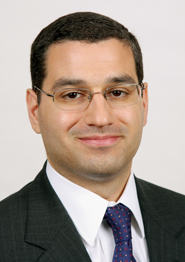
Wall Street has a long history of internecine warfare among market centers such as the New York Stock Exchange and Nasdaq. Recent times are no different. A relatively obscure order type made popular by Direct Edge ECN has managed to generate a firestorm of controversy, with exchanges and broker-dealers alike now trash-talking the tactic.
At an industry conference on market structure in May, a panel on market centers broached the subject of "flash" orders and almost ended in fisticuffs. In one corner was defending champion William O’Brien, CEO of Direct Edge. In the other was Larry Leibowitz, his hot-under-the-collar opponent from the Big Board.
Leibowitz threw the first punch by leveling charges of elitism at O’Brien’s market. The head of U.S. execution and global technology at NYSE Euronext assailed Direct Edge’s Enhanced Liquidity Provider or ELP program as the "enhanced look" program, comparing it to the advance look at orders that NYSE specialists used to get. That practice was seen as giving specialists unfair advantages over other market participants, and potentially disadvantaging order senders.
"That’s slander!" O’Brien shot back. "You can’t say that!" As for elitism, O’Brien observed that the NYSE has "more tiers than Yankee Stadium." The discussion took place at the Securities Industry and Financial Markets Association annual spring conference on market structure.
Brief Display
Behind the war of words was news that Nasdaq and BATS Exchange planned to introduce flash orders of their own. They subsequently did, and there are now four market centers that offer flash orders, including the CBOE Stock Exchange, which was first to conceive of this functionality for an equities market.

Flash orders are also called "step up" or "pre-routing display" orders. The rationale for these order types is simple: Better me than you. They allow a venue to execute marketable orders in-house when that market is not at the national best bid or offer, instead of routing those orders to rival markets. They do this by briefly displaying information about the order to the venue’s participants and soliciting NBBO-priced responses. If there are no responses, the order can be canceled or routed to the market with the best price.
All four markets with flash orders treat these orders in a similar way. If they get a marketable buy order, for instance, that would otherwise be routed to a market quoting at the NBBO, they flash the order to some or all of their participants as a bid at the same price as the national best offer. Exactly who sees the flash, how that information is conveyed and the duration of the flash vary by market. The maximum allowable time for a flash is 500 milliseconds, or half a second, although most of the markets flash routable orders for under 30 milliseconds.
NYSE Euronext’s anti-flash tirade didn’t end with the SIFMA conference. The exchange operator, along with market-making firm GETCO and SIFMA, weighed in on the Nasdaq and BATS flash order types with formal letters to the Securities and Exchange Commission. NYSE and SIFMA urged the SEC to abrogate the Nasdaq rule filing and reject BATS’s filing. All three pushed the SEC to study the potential impact of flash orders on the marketplace before deciding whether to give them free rein.
NYSE and GETCO charged that markets with flash orders were essentially running private markets of quotes for select participants that competed with the public quote stream. With Nasdaq and BATS rolling out new order types to combat Direct Edge, the upshot, in their view, was bad market structure and probably eventual harm to investors.
These firms and SIFMA argued that flash order types call into question some of the basic tenets of the equities market structure. In various combinations, they claimed that the effort to keep flow in-house undermines the concept of a quotation, impairs the meaningfulness of the NBBO, jeopardizes liquidity provision by hurting liquidity providers quoting at the NBBO, and potentially upsets the pursuit of best execution.
The Quote Rule
The SEC is carefully tracking the flash issue. David Shillman, an associate director at the Commission’s Division of Trading and Markets, said at the SIFMA conference that flash orders lasting less than 500 milliseconds fall within an exception to the Quote Rule, or Rule 602, in Regulation NMS. The Quote Rule requires all market centers to publicly disseminate their best bids and offers through the securities information processors. The exception is for orders that are immediately executed or canceled.

However, the SEC’s thinking on this issue isn’t settled and may be re-examined, Shillman said. "It’s an open question as to whether the Quote Rule should be modified, whether it is really necessary to have that [exception] in the electronic world," he told the SIFMA crowd.
Nasdaq and BATS launched their flash order types partly because of Direct Edge’s gain in matched market share in recent months. In May, the ECN’s market share was 12.2 percent, compared with less than 7 percent in December. Nasdaq’s share in May was 19.8 percent, while BATS’s was 10.2 percent. Another reason for these latest flash order types, according to market participants, may have been Direct Edge’s regulatory filing, in May, to convert its two ECN markets into exchanges. Becoming an exchange could give Direct Edge a market-share boost.
Nasdaq implemented flash orders to compete with Direct Edge. "This gets us on a level playing field with the competition," said Brian Hyndman, senior vice president for Nasdaq transaction services. "This benefits our customers, and client demand drove us to introduce this order type."
For BATS, offering flash orders, which it calls BOLT orders, was also a business decision. "We’re going down the path we are because the SEC has said it’s legal," said Joe Ratterman, CEO of BATS. "If they authorize other firms to employ similar programs, BATS doesn’t want to be left at a disadvantage [based on] market structures other venues may use."
NYSE Euronext, despite frowning on flash orders, may wind up joining the party. Joe Mecane, executive vice president for U.S. markets at the company, notes that if the SEC allows these flash order types to stand, NYSE Arca would probably convert an existing order type into a flash-type interaction, and would look to more broadly disseminate that information. "If the SEC is implicitly allowing private access to information, we’ll need to do it to be competitive," he said. NYSE Euronext may decide to offer flash orders on the NYSE as well, Mecane said. Nasdaq, for its part, is implementing a flash-type order this month on Nasdaq OMX BX, its Boston equities market.
In the Lurch
The primary argument against flash orders is that they create private markets and are therefore a step back for market structure. "These programs are creating a private locked market for a small group of participants, and they are holding up the execution process for that marketable order," Mecane said. He added that the Big Board operator isn’t against dark pools, competition or innovative business models. "Our issue is that this creates a tiered market," he said.
Market maker GETCO told the SEC that by creating a two-tiered market, flash orders give professionals receiving the flashes a leg up over other investors. Non-public quotes could also "negatively affect the broader market, including retail investors who rely on the NBBO to ensure that their orders obtain the best, reasonably available price," the firm said. GETCO argued that flash orders, like dark liquidity that executes at the NBBO, also leave limit orders that established the best price in the lurch.
Jamie Selway, managing director at institutional broker White Cap Trading, believes that flash orders undermine aspects of Reg NMS, including the requirement that brokers and exchanges avoid locked markets. A locked market occurs when a protected bid equals a protected offer. "Firms are locking the market by design, but not by the SEC’s definition," Selway said. "The problem with the way the SEC has architected this exception to quoting requirements is that it’s now a private locked market instead of a public locked market. This kludge of a half-second definition is brand new."
Direct Edge’s O’Brien draws a distinction between how the information his market disseminates is seen and what Nasdaq and BATS are doing. His flashes, he said, are sent out on a different data feed than the ECN’s depth-of-book feed, while Nasdaq’s and BATS’s flash orders are not. As a result, the latter exchanges’ feeds look like they’re locking the market. (Last month, both exchanges added a flag to flashed orders to identify them for subscribers.)

In Selway’s view, this argument clouds the point. The point, he said, is that order messages are being broadcast at prices that, effectively, lock protected quotes. This creates an elite tier of traders with access to better-priced orders than those receiving public quotes through the securities information processors, giving flash recipients an information advantage, he said.
In its letter, SIFMA made a related point. It complained to the SEC that flash orders raise "fair access issues." A two-tiered market, SIFMA wrote, will lead to a playing field in which "some [investors are] able to pay for a non-public direct feed to trade with better-priced quotes versus those quotes that are accessible to the general public." It also said that broker-dealers unable to readily distinguish flash quotes from protected quotes could run into compliance problems with Reg NMS and their best-execution obligations, since those obligations are tied to the official NBBO.
Best Execution
Flash orders could make satisfying best-execution obligations problematic by improperly influencing routing decisions as well. Several broker-dealers told Traders Magazine that the beneficial pricing associated with flash orders creates incentives for brokers to send flow to non-NBBO markets that have flash orders. Firms whose orders are flashed pay a lower liquidity-taker fee for those executions on Direct Edge than they do for regular executions. On Nasdaq and BATS, they get a rebate instead of paying a fee. (CBSX charges the same fee for regular and flash orders.)
Another best-execution issue is that broker-dealers seeking flash executions could miss executions if the NBBO changes during the flash period. Larry Harris, a finance professor at the University of Southern California and a former chief economist at the SEC, notes that exchanges generally are not allowed to trade through better-priced protected quotes, although they can trade at that price. "But the flip side is that the exchange may lose the opportunity to obtain a trade at that price if they hold the order during the flash period," he said. "The person who submitted the order to the flash process takes the risk that the NBBO will change or that no one will respond while the order at the other market disappears."
Great Executions
Christopher Nagy, managing director for order routing, sales and strategy at TD Ameritrade, said his firm’s experience with Direct Edge’s flash orders has been positive. Ameritrade began using Direct Edge’s ELP program when it started in 2006. "We saw that clients were getting great executions on limit orders, and a more consistent execution experience, so we continued utilizing the program," he said.
For investors, Nagy continued, flash orders avoid slippage concerns associated with displayed orders. "Reg NMS doesn’t incentivize retail or institutional orders to display their hands for fear of slippage," he said. "If you can enter a transparent environment but essentially be hidden, you’re more apt to transact in that world." He added that Ameritrade usually receives better prices than the NBBO on Direct Edge.

Direct Edge’s O’Brien argues that critics of his market’s ELP program are twisting a successful innovation into a regulatory concern for purely competitive reasons. He said the ELP program gives participants a choice about how they want their order flow handled, and enables customers to lower their market-impact and transaction costs. He also notes that critics of the ELP program, which includes dark pools among its participants, are anti-internalization. Internalization refers to the ability of brokers to match customer orders away from public markets. But the ECN’s flash orders, on the contrary, O’Brien said, have "democratized access to dark liquidity sources by enabling retail customers to choose to interact with that liquidity to seek larger-size executions and potentially better prices."
Despite its introduction of flash orders, BATS Exchange shares NYSE Euronext’s concern about tiered markets. Ratterman notes that flash order types create a private market for an exchange’s participants. He stresses that the consolidated tape has been a valuable reference point for three decades. "If we go down the path where that doesn’t reflect the best quotes in the market, that’s not a good outcome," Ratterman said. "And the amount of time the quotations are flashed and not provided to the consolidated tape shouldn’t be a deciding factor."
NBBO Matches
Another significant issue raised by flash messages is the impact they could have on public limit orders. Ratterman points out that flash orders could affect the price-discovery process by curtailing the executions received by those establishing the NBBO. "A flash order takes advantage of the price-formation risk of someone at the NBBO without rewarding that person with an execution," he said.
Economist Harris agrees, but adds a caveat. "At present, executing at the NBBO is subject to the preferences of customers," he said. "It seems to be consistent with the present regulatory legal framework that traders on or off the exchange are allowed to match the NBBO on request. If you oppose this system, you’re basically saying brokers or exchanges have a responsibility to satisfy clients of other exchanges, and regulators have never said that."
In his view, however, flash orders could affect the quality of the markets, if they come to represent enough liquidity. He describes flash orders as an example of exchanges competing for order flow at the expense of competition for the best price. "The implication is that traders would not post limit orders as aggressively as they otherwise would, and that would not be in the public interest," Harris said. "Theoretically, the bid-ask spread could widen." He added that the SEC "has been willing to protect traders offering liquidity at the NBBO only against trade-throughs in the name of protecting the order submitter [from executing at an inferior price]," but that the regulator may now have to think about the extent of the protection they are willing to offer those establishing the NBBO.
At the SIFMA conference, the SEC’s Shillman said the Commission considers competition between limit orders critical to robust price discovery. If it appears that an increase in "dark volumes" is undermining that process, he said, the SEC might look at new ways to reward limit orders that establish the best price. One option he highlighted would be to give displayed limit orders at the NBBO protection against executions at the same price. That would require executions at the NBBO to first trade against the price-setting interest available in the displayed market.
Nasdaq’s Hyndman doesn’t think limit orders are likely to be affected by flash orders. "We don’t think this market structure functionality is bad for limit orders," he said. "We don’t know how it will play out, since it’s a new innovation for exchanges, but we’ll see what’s changed after a couple months." He added that the SEC is likely to keep its eye on flash orders "in the same vein that they’re keeping an eye on dark pool growth."
SIDEBAR: STOC Talk
Direct Edge was not the first equities market to think up a flash order. The progenitor of the flash among equities markets is the CBSX, which launched in March 2007 as a Regulation NMS-compliant market. This is significant because NYSE Euronext argues that flash orders run afoul of Rules 602 and 604 of Reg NMS. Rule 602, the Quote Rule, requires market centers to publicly disseminate their best bids and offers, and Rule 604 requires customer limit orders to be publicly displayed. The three other markets with flash or step-up orders have all referenced, in public comments or rule filings, CBSX’s flash functionality as the basis for their order types.
The CBSX, however, distances itself from the current battle over flash orders. "It’s not our fight," said David Harris, CEO of the exchange. His exchange’s reason for the flash is different, he said. He also noted that CBSX’s flash is an "operational process" approved by the SEC and not an order type.
CBSX developed its flash functionality so its Chicago-based participants could potentially get quicker executions from Chicago-based flash responders and avoid having their order routed 712 miles east for a fill. The exchange’s flash process was approved in early September 2006 as part of the rule set for the STOC system, the CBOE’s small facility to execute securities that were not options. (The initial rule filing for stock trading was submitted to the SEC in 2004.) Rules making STOC NMS-compliant were approved in late September 2006, and the CBSX, which replaced STOC, got the SEC’s nod in March 2007.
(c) 2009 Traders Magazine and SourceMedia, Inc. All Rights Reserved.
http://www.tradersmagazine.com http://www.sourcemedia.com/




